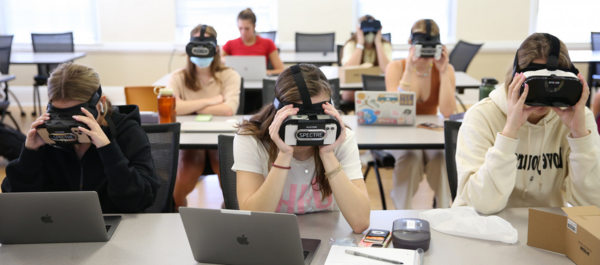
Can VR Teach Students Ethics?
Virtual reality courses have become more common, thanks to the development of new classroom applications for the software and the increased affordability of VR and augmented reality technology for institutions. A 2025 survey of chief technology officers by Inside Higher Ed and Hanover Research found that 14 percent of respondents said their institution has made meaningful investments in virtual reality and immersive learning.
Past research shows that VR activities benefit student learning by making the classroom more engaging and encouraging creative and entrepreneurial thinking.
A group of faculty at Pepperdine University in California adapted virtual reality content to teach undergraduates about ethical systems in a practical and applied setting.
Their research study, published in the Journal of Business and Technical Communication, showed that students who used VR in a case study had a heightened emotional response to the material, which clouded their ability to provide a measured analysis. By comparison, students who watched a straight video about the same case not only expressed empathy for the subjects but also maintained a clear view of their situation.
How it works: The research study evaluated student learning over the course of two semesters in 2023. Students were presented with three variations of a case study related to the Malibu Community Labor Exchange, a nonprofit organization that helps day laborers and individuals without housing secure work. Students read a news article and watched a VR video or watched a standard video about the lives of workers at the MCLE, which provides a variety of opportunities for individuals in the Los Angeles region. Some watched both VR and a standard video.
Course content focused primarily on the workers, their personal lives, their role in addressing wildfires in Malibu and the risks they face in fighting fires.
After watching the materials, students had to connect the ethical questions presented about MCLE’s mission and workers’ conditions with a previously taught lesson about ethicists and their ethical systems, as well as write a recommendation for the organization.
Faculty reviewed students’ responses to identify whether they exhibited appropriate reasoning about ethical systems and whether their recommendations reflected their ability to interpret the content.
The takeaways: In their reflections, students underscored the way videos exposed them to someone else’s circumstances and realities, saying the content felt very authentic. But those who used VR were more likely to say the format was distracting than those who saw only videos.
Students who watched the standard video said it helped them expand their understanding of the organization, its members and the context of the work in an emotional and logical way. They wrote that they felt empathetic and had a richer sense of the work being done.
“The video was very raw. It didn’t glamorize or have fantastic editing. It showed us exactly what it is like for these workers,” one student wrote.
For some students, the VR video was more powerful because it was more “shocking and realistic than seeing the video in normal format,” one course participant wrote. Instructors noted students were almost too personally affected by the first-person vantage point to talk about the organization and the ethical systems from an objective or factual perspective.
Students who watched only the VR were also more likely to conflate the experience with reality, calling it a “true view” instead of a representation or interpretation of events; students who watched a standard video as well as the VR version had a more balanced perspective.
Based on their findings, researchers suggest that using both standard and VR videos that require students to reflect, analyze and recommend solutions can increase students’ “practical wisdom,” or balancing cognition and emotion for ethical action, as researchers defined it.
“Rather than assuming that students know how to critically evaluate visual messages and their emotions, we need to intentionally teach students how to develop visual literacy and practical wisdom, especially by using VR video,” researchers wrote in the article.

Source link


